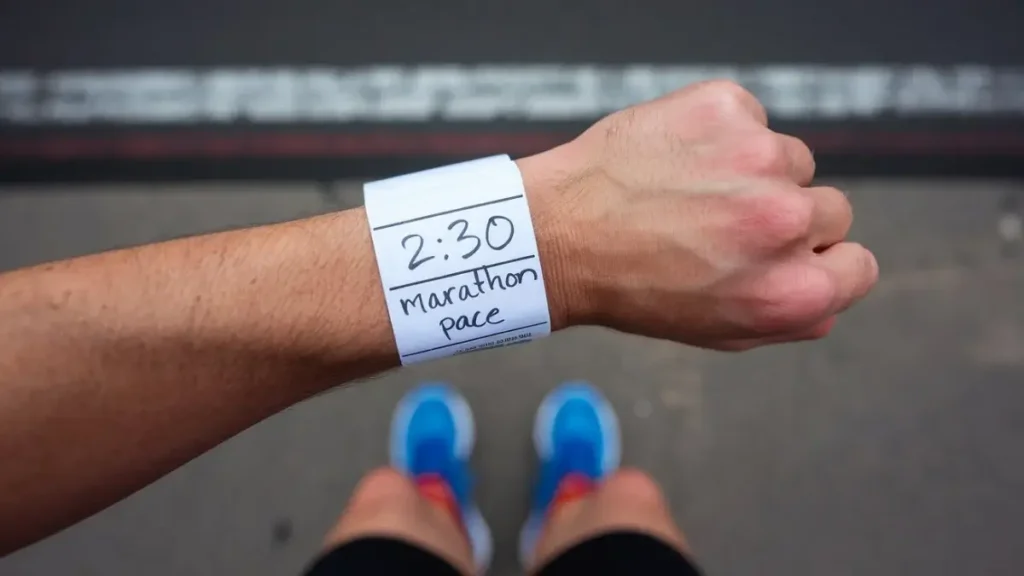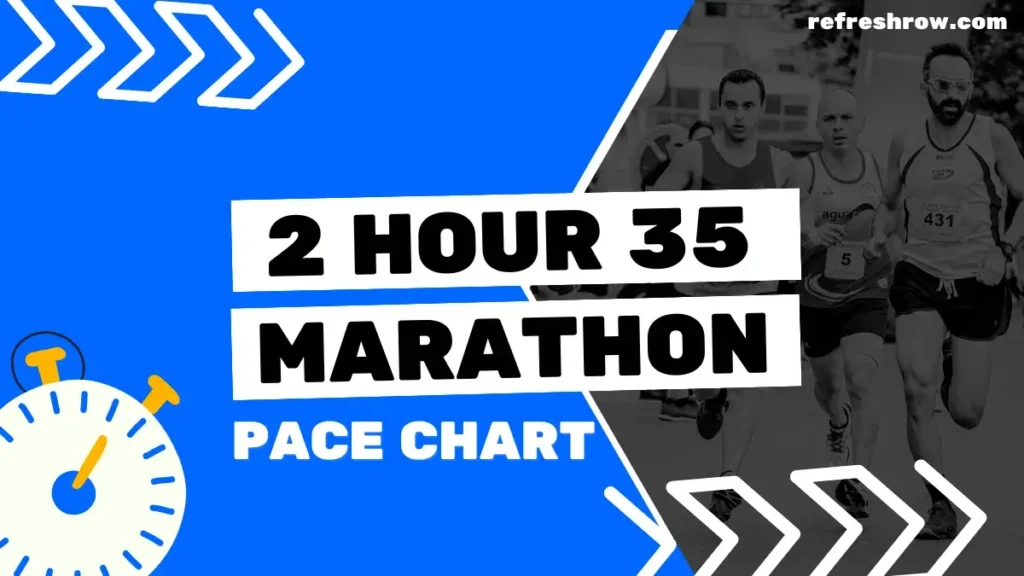To run a 3:15 hour marathon you need to run at a pace of 7:26 per mile or 4:37 per kilometer.
Following the splits below (and shaving off a second), you’ll run a sub 3:15 marathon.
I’d recommend aiming to run 1-2 minutes ahead of the split target time from 10 miles, as you’ll likely come up against crowding on race day.
3:15 Marathon Pace in Miles
| Mile | Split |
|---|---|
| 1 | 7:26 |
| 2 | 14:52 |
| 3 | 22:19 |
| 4 | 29:45 |
| 5 | 37:11 |
| 6 | 44:37 |
| 7 | 52:04 |
| 8 | 59:30 |
| 9 | 1:06:56 |
| 10 | 1:14:22 |
| 11 | 1:21:49 |
| 12 | 1:29:15 |
| 13 | 1:36:41 |
| 14 | 1:44:07 |
| 15 | 1:51:34 |
| 16 | 1:59:00 |
| 17 | 2:06:26 |
| 18 | 2:13:52 |
| 19 | 2:21:19 |
| 20 | 2:28:45 |
| 21 | 2:36:11 |
| 22 | 2:43:37 |
| 23 | 2:51:04 |
| 24 | 2:58:30 |
| 25 | 3:05:56 |
| 26 | 3:13:22 |
| 26.2 | 3:15:00 |
Download
3:15 Marathon Pace in KM
| KM | Split |
|---|---|
| 1 | 4:37 |
| 2 | 9:15 |
| 3 | 13:52 |
| 4 | 18:29 |
| 5 | 23:06 |
| 6 | 27:44 |
| 7 | 32:21 |
| 8 | 36:58 |
| 9 | 41:36 |
| 10 | 46:13 |
| 11 | 50:50 |
| 12 | 55:27 |
| 13 | 1:00:05 |
| 14 | 1:04:42 |
| 15 | 1:09:19 |
| 16 | 1:13:57 |
| 17 | 1:18:34 |
| 18 | 1:23:11 |
| 19 | 1:27:48 |
| 20 | 1:32:26 |
| 21 | 1:37:03 |
| 22 | 1:41:40 |
| 23 | 1:46:18 |
| 24 | 1:50:55 |
| 25 | 1:55:32 |
| 26 | 2:00:09 |
| 27 | 2:04:47 |
| 28 | 2:09:24 |
| 29 | 2:14:01 |
| 30 | 2:18:39 |
| 31 | 2:23:16 |
| 32 | 2:27:53 |
| 33 | 2:32:30 |
| 34 | 2:37:08 |
| 35 | 2:41:45 |
| 36 | 2:46:22 |
| 37 | 2:51:00 |
| 38 | 2:55:37 |
| 39 | 3:00:14 |
| 40 | 3:04:51 |
| 41 | 3:09:29 |
| 42 | 3:14:06 |
| 42.2 | 3:15:00 |
Download
Other Marathon Pace Charts
Targeting a different time?
Check out the Full Marathon Pace Chart in Miles or KM
Or select a specific finishing time below:
| 3:00 | 4:00 | 5:00 | |
| 3:05 | 4:05 | 5:15 | |
| 3:10 | 4:10 | 5:30 | |
| 3:15 | 4:15 | 5:45 | |
| 3:20 | 4:20 | 6:00 | |
| 3:25 | 4:25 | 6:15 | |
| 2:30 | 3:30 | 4:30 | 6:30 |
| 2:35 | 3:35 | 4:35 | 6:45 |
| 2:40 | 3:40 | 4:40 | 7:00 |
| 2:45 | 3:45 | 4:45 | |
| 2:50 | 3:50 | 4:50 | |
| 2:55 | 3:55 | 4:55 |
Training for a 3:15 Marathon
Is 3:15 a Good Marathon Time?
Well, what do the stats say?
Run Repeat conducted a study that contains 19,614,975 marathon results from more than 32,335 races across the globe, here is how a 3:15 marathon compares against age and gender for the races recorded:
| Overall | You’re faster than 95.4% of all runners. |
| Male | You’re faster than 92.9% of males. |
| Female | You’re faster than 98.8% of females. |
| <20 | You’re faster than 92.4% of under 20s. |
| 20-29 | You’re faster than 92.7% of 20-29 year olds. |
| 30-39 | You’re faster than 93.6% of 30-39 year olds. |
| 40-49 | You’re faster than 96.3% of 40-49 year olds. |
| 50-59 | You’re faster than 98.7% of 50-59 year olds. |
| >60 | You’re faster than 99.7% of over 60s. |
Training Runs and Paces for a 3:15 Marathon
To break a 3:15 marathon you’ll need to do some serious distance in your training, I recommend at least 35 miles (56km) per week.
You’re also going to need to make sure you’ve crossed off these milestones for other race distances:
- A 5k in 20:15 mins
- A 10k in 42:20 mins
- A half marathon in 1 hour 29 mins
Training Paces
| Pace | Mins per Mile | Mins per KM |
|---|---|---|
| Easy | 8:23 | 5:12 |
| Steady | 7:26 | 4:37 |
| 10k | 6:49 | 4:14 |
| 5k | 6:32 | 4:04 |
| 1 Mile | 6:04 | 3:47 |
Weekly Mileage Targets
| Target Mileage: | Gradually increase your weekly mileage from 40 miles (64 km) to a peak of 68 miles (109 km). |
| Incremental Increase: | Increase mileage by approximately 10% each week, with every fourth week as a recovery week where mileage is reduced by 20-30%. Make sure to taper for the last 1-2 weeks. |
Long Run Structure
| Total Distance: | Build up to long runs of 20-22 miles (32-35 km). |
| Segment Example: | First 5 miles (8 km): Easy pace, heart rate 140-150 bpm (approximately 8:30/mile or 5:17/km). Next 1 mile (1.6 km): Fast pace at 6:20/mile (3:55/km). Next 5 miles (8 km): Medium effort, heart rate around 160 bpm (approximately 7:20/mile or 4:33/km). Repeat: Repeat the segment twice (5 miles easy, 1 mile fast, 5 miles medium), you can taper the final 2 miles if required. |
Why This Works: Incorporating varied paces within long runs enhances lactate tolerance, which helps on race day when you’ve got to maintain pace despite feeling fatigued. By practicing surges during a run, you can build up your physical and mental resilience (lots of elite marathon runners use these strategies during their training)
Alternating Long Runs: Alternate between structured long runs (easy/fast segments) and easier long runs. For easier long runs, maintain a steady, comfortable pace throughout, focusing on mileage rather than speed to aid recovery.
Speedwork Sessions
| Short Intervals: | – 800m repeats at 3:10 per interval (3:55/km). – Aim for 6-12 repetitions with equal time for recovery. |
| Mile Repeats: | – 1 mile repeats at 6:20 per mile (3:55/km). – Aim for 6-12 repetitions with a 1-2 minute recovery jog. |
| Longer Intervals: | – 2 mile repeats at 6:30 per mile (4:02/km). – Aim for 5-8 repetitions with a 2-3 minute recovery jog. |
Recovery and Rest Days
| Rest Days: | You don’t need to incorporate rest days if you are using recovery runs, but I recommend taking 1 (or a max of 2) per week to allow your body to recover and prevent overtraining. |
| Easy Run Days: | Include 1-2 easy run days per week at a relaxed pace of 9:00/mile (5:36/km), covering 5-10 miles (8-16 km) per day. Try to keep your heart rate below 140 bpm on easy days to ensure proper recovery and aerobic development. |
My Tips to Run a Sub 3:15 Marathon
Emphasize Consistent Training and Recovery
From my own journey to running a 3:15 marathon, one of the most critical aspects was maintaining consistent training while prioritizing recovery.
I found that sticking to a structured training plan, with clearly defined workouts and rest days, made a significant difference.
My plan included a mix of long runs, tempo workouts, and interval sessions like those laid out above, but what really helped me stay injury-free was respecting recovery days and not pushing it.
On these days, I focused on light activities like walking or gentle swimming, ensuring my muscles had time to repair and strengthen. But also scratched that fitness itch that kept me on track without overtraining.
Tailor Your Nutrition Plan Through Trial and Error
Every runner’s nutritional needs are unique, and finding what works best for you can require some experimentation.
Throughout my training, I tested various gels, drinks, and solid foods to see what my stomach could handle during long runs.
For me I found that a combination of sports drinks and energy gels worked best for me, providing the necessary carbs and electrolytes without causing gastrointestinal distress.
Additionally, I paid close attention to my pre-run meals, opting for easy-to-digest options like oatmeal with a banana and peanut butter.
Make sure you work out what works for you before race day, so you’re not tempted to try anything new.
Integrate Tempo Runs to Boost Endurance and Speed
In my experience, tempo runs were a game-changer in preparing for a 3:15 marathon.
These runs, typically performed at a “comfortably hard” pace, helped bridge the gap between easy runs and race pace efforts.
For my training, I incorporated tempo runs of 6-10 miles at a pace slightly faster than my marathon goal pace.
This not only improved my lactate threshold, making race pace feel easier, but also boosted my overall speed and endurance.
Regularly integrating tempo runs into my weekly schedule gave me the confidence and stamina to sustain a strong, steady pace on marathon day.
Develop Mental Resilience and Positive Self-Talk
Marathon running is as much a mental challenge as it is a physical one.
I learned the importance of developing mental resilience through techniques like visualization and positive self-talk.
During my training, I practiced visualizing different parts of the race, especially the more challenging final miles.
I also held on to the mantra that I repeated during tough moments: “Who’s gonna carry the boats, and the LOGS!”, gifted to us by the ever-motivating David Goggins.
This simple phrase became my mental anchor, helping me push through fatigue and maintain focus.
Building this mental toolkit was crucial on race day, enabling me to stay positive and determined even when the going got tough.


Row Brown is the founder of Refresh Row. He is a keen marathon runner, his favorite being the London Marathon. He’s now set himself the mission of Running the Entire Length of Spain, which is scheduled for late 2024.


